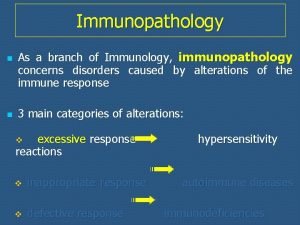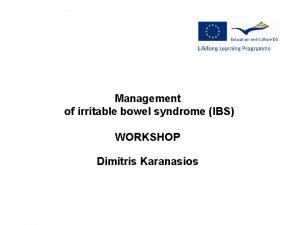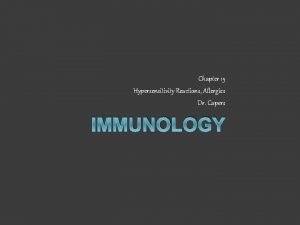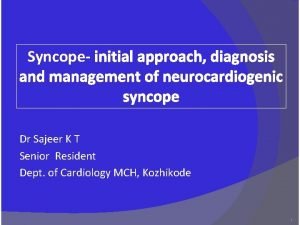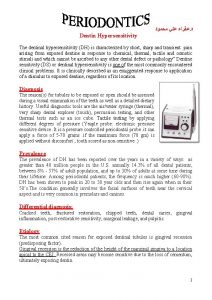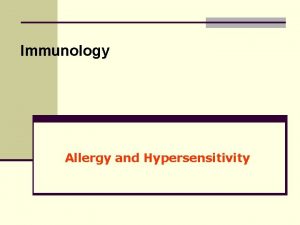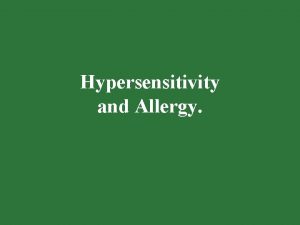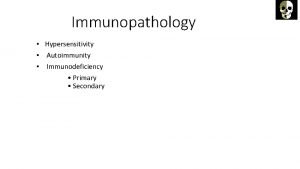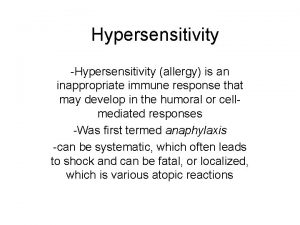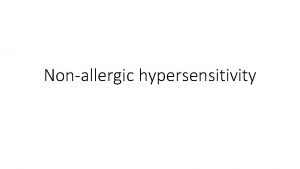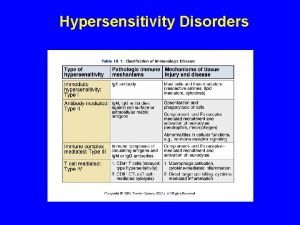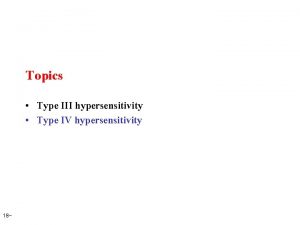Hypersensitivity dispositions as clinical findings Hypersensitivityallergicpseudoallergic dispositions May









- Slides: 9

Hypersensitivity dispositions as clinical findings

Hypersensitivity/allergic/pseudoallergic dispositions • May be considered as findings about potential adverse conditions such as diseases, structures, processes

Summary of proposed changes • Move hypersensitivity/allergy/pseudoallergy condition under clinical finding. • Make all of the above conditions primitive • Move 420134006 |Propensity to adverse reactions (disorder)|under clinical finding • The condition classes would have only 3 asserted subhierarchies: • Hypersensitivity/allergic/pseduoallergic disease • Hypersensitivity/allergic/pseudoallergic disposition • Hypersensitivity/allergic/pseudoallergic reaction

Hypersensitivity/allergic/pseudoallergic diseases • Model: • Due to pathological process (i. e. due to allergic reaction) • Example: • Allergic rhinitis (disorder) • is. A disease (disorder) • is. A Allergic condition (finding) • due to type 1 hypersensitivity response (disorder) • RG {finding site structure of mucous membrane of nose (body structure)+ associated morphology inflammation} • Fully define these as a disease due to allergic reaction or a specific subtype of allergic reaction {caused by substance x} • The above is how allergic diseases were defined at the onset and several existing examples currently in SNOMED still use this model • This removes the uncertainty around these being either dispositions or reactions but as a specific temporal relationship is not mentioned, it leaves open the possibility that the causative allergic reaction is either still present at the time of the manifestation or that it has resolved.

Hypersensitivity/allergic/pseudoallergic dispositions • Model: • Has realization pathological process i. e. allergic process (or allergic reaction process? ) • Model these as propensity to adverse reactions has realization allergic process • The current range for has realization is 719982003 |Process (qualifier value)| • Move 308489006 |Pathological process (qualifier value)|under 719982003 |Process (qualifier value)| • Add causative agent substance and its appropriate descendants to a role group with has realization allergic process to indicate that the allergen causes the realization of the disposition and not the disposition itself. • Example Allergy to penicillin • is. A propensity to adverse reactions (finding) • is. A allergic condition (finding) • RG {has realization allergic process (or allergic reaction process ? ) + causative agent penicillin}

Hypersensitivity/allergic/pseudoallergic reactions • Model: • Pathological process allergic (or allergic reaction? ) process • Model as adverse reaction pathological process allergic process {caused by substance x} • Example • Allergic reaction to penicillin • is. A adverse reaction (disorder) • is. A allergic condition (finding) • Pathological process allergic process (or allergic reaction process ? )

Summary of hypersensitivity/allergy hierarchies Should all be findings

Pseudoallergy

Hypersensitivity/allergy/pseudoallergy models - summary • Hypersensitivity/allergy/pseudoallergy condition (finding) • Primitive groupers for hypersensitivity/allergy/pseudoallergy diseases, dispositions and reactions (processes) • Hypersensitivity/allergy/pseudoallergy disease (disorder) • Disorder due to allergic reaction • Hypersensitivity/allergy/pseudoallergy disposition (finding) • Propensity to adverse reactions has realization hypersensitivity/allergy/pseudoallergy process • Hypersensitivity/allergy/pseudoallergy reaction (disorder) • Adverse reaction pathological process hypersensitivity/allergy/pseudoallergy process




